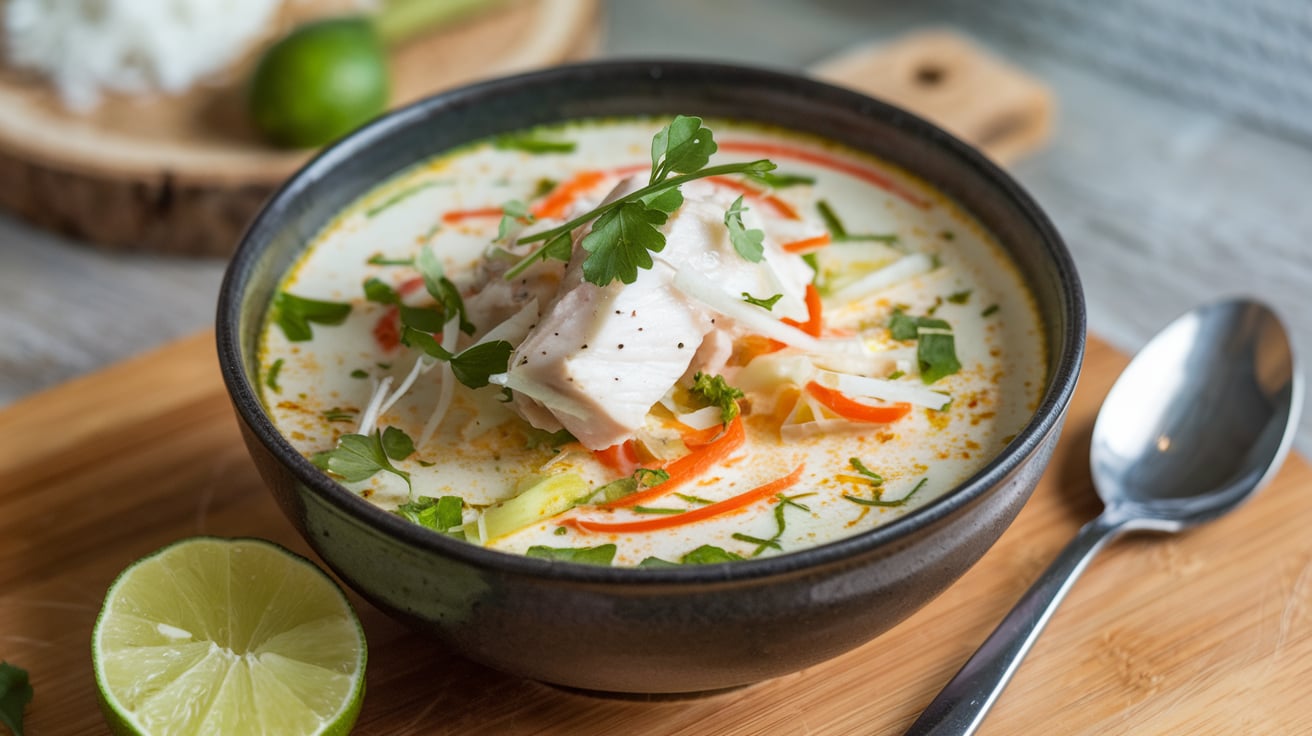Imagine a soup bursting with flavor – spicy, tangy, and creamy all at once. That’s exactly what you get with Spicy Coconut Lime Soup with Halibut. This delicious soup is inspired by the vibrant flavors of Southeast Asia. It’s like a warm hug on a chilly evening.
This Spicy Coconut Lime Soup with Halibut is surprisingly easy to make. Even if you’re new to cooking, you can follow the simple steps. It’s a healthy choice too. The soup is packed with fresh ingredients like lemongrass, ginger, and cilantro. Halibut is a fish that’s full of protein and good for you.
My grandmother always said the best meals are made with love and fresh ingredients. She taught me everything I know about cooking. This soup reminds me of our time together in her kitchen. We’d spend hours chopping vegetables and telling stories. This recipe is my way of sharing her love of food with you. I hope it brings your family as much joy as it brings mine. If you enjoy this soup, you might also like my other Asian inspired recipes.
About Halibut: The Star of the Soup
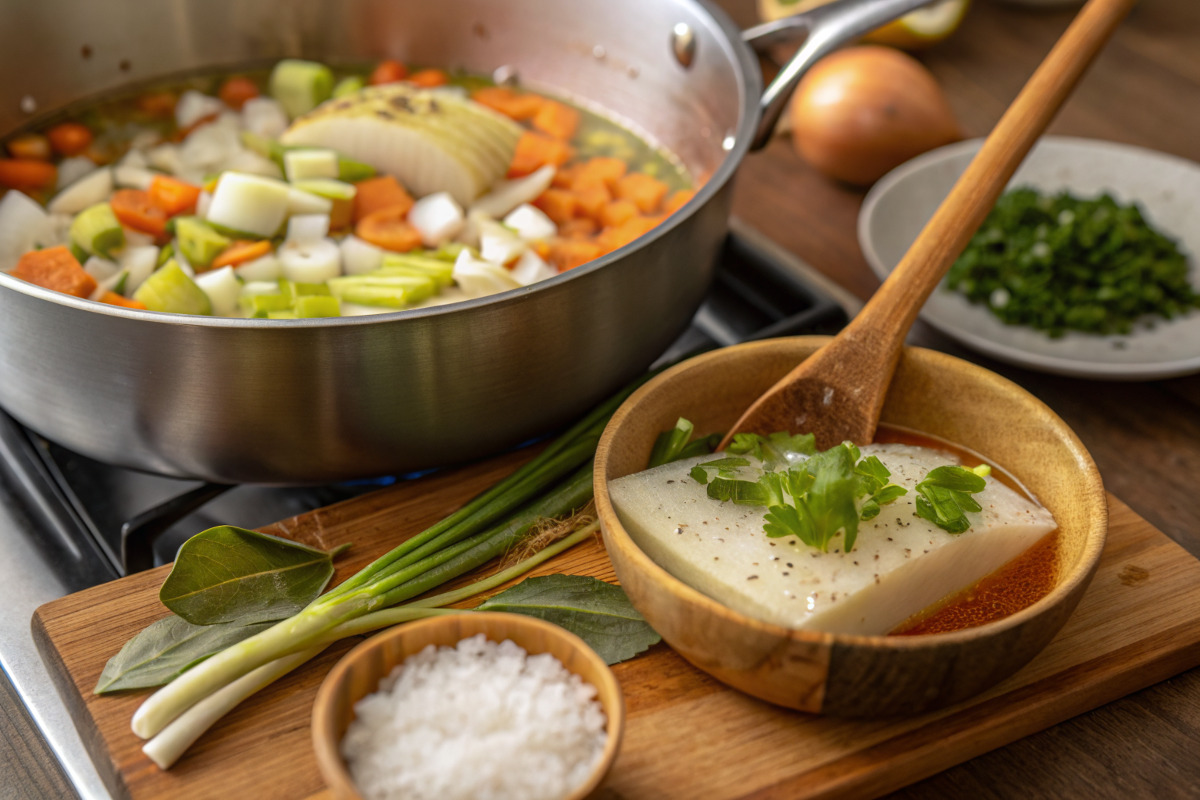
What is Halibut?
Halibut is a large, flat fish that lives in the cold waters of the Pacific and Atlantic oceans. It’s a popular choice for seafood lovers because of its mild, sweet flavor. Halibut has a firm, flaky texture that holds up well in cooking. It doesn’t fall apart easily, making it perfect for soups and stews. Think of it as a blank canvas that soaks up the flavors of the broth. It’s also low in fat and high in protein, a healthy and delicious option!
Why Choose Halibut for this Soup?

Halibut’s delicate flavor doesn’t overpower the bold flavors of the coconut lime broth. Instead, it absorbs the spicy, tangy, and creamy notes beautifully. The firm texture of the halibut stands up to the simmering broth, ensuring each bite is satisfying. It becomes infused with the aromatic flavors of lemongrass, ginger, and lime.
For a fun twist on breakfast, try these Mini Cinnamon Rolls.
If you can’t find halibut, other firm white fish like cod or snapper can be used. They have a similar texture to halibut. However, cod has a slightly sweeter taste, while snapper is a bit more delicate. Using these fish might change the overall flavor of the soup just a little. You might need to adjust the cooking time too, as these fish can cook faster than halibut. But don’t worry, your soup will still be delicious!
Gathering Your Ingredients: A Shopping List for Spicy Coconut Lime Soup with Halibut
Fresh Produce
- Lemongrass: 2 stalks, choose firm and fragrant ones.
- Ginger: A 2-inch piece, look for smooth skin.
- Garlic: 4 cloves, plump and firm are best.
- Onion: 1 medium yellow onion.
- Red bell pepper: 1, choose a firm and brightly colored one.
- Cilantro: 1 bunch, fresh and vibrant green.
- Lime: 2, for that zesty kick!
Pantry Staples
- Coconut milk: 1 (13.5 oz) can, full-fat recommended for a creamy soup.
- Fish sauce: 2 tablespoons, adds a savory depth (can substitute with soy sauce).
- Chili garlic sauce: 1-2 tablespoons, adjust to your spice preference.
- Vegetable broth: 4 cups, low-sodium preferred.
- Rice noodles: 8 ounces, any width you like.
Halibut Selection and Preparation
Look for fresh halibut fillets that are firm, white, and have a clean smell. Ask your fishmonger for help if you’re not sure. Rinse the fillets under cold water and pat them dry with a paper towel. Cut the fish into 1-inch pieces so they cook evenly in the soup. Now you’re ready to start cooking!
This recipe pairs well with a decadent dessert. Check out my recipe for Cheesecake Brownies.
Cooking the Spicy Coconut Lime Soup with Halibut: A Step-by-Step Guide
Building the Flavor Base: Aromatics and Spices
First, let’s build a flavorful foundation for our soup. Trim the ends off the lemongrass stalks and peel off the tough outer layers. Use a knife to finely chop the tender white part of the lemongrass. Peel and mince the ginger and garlic. Dice the onion. In a large pot or Dutch oven, heat a tablespoon of oil over medium heat. Add the lemongrass, ginger, garlic, and onion. Cook for about 5-7 minutes, stirring occasionally, until softened and fragrant. This creates a delicious aroma that will fill your kitchen.
Creating the Broth: Coconut Milk and Seasoning
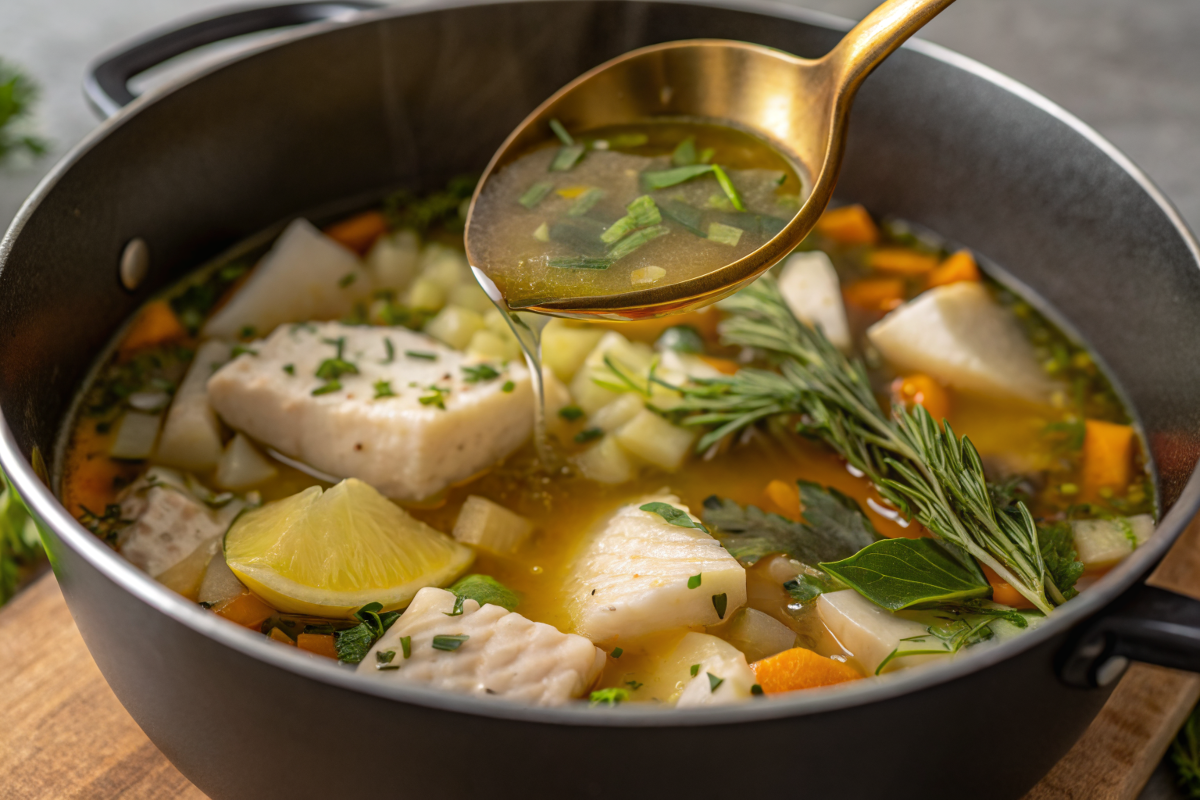
Now, it’s time to build the creamy, flavorful broth. Pour in the can of coconut milk and the vegetable broth. Stir well to combine. Add the fish sauce and chili garlic sauce. Start with one tablespoon of chili garlic sauce and taste. You can always add more later if you like it spicier. Remember, you can always add more spice, but you can’t take it away! Let the broth simmer for about 10 minutes to allow the flavors to meld. This simmering process helps the spices infuse the broth, creating a deeper, richer flavor.
For another great breakfast option, you can find my recipe for Breakfast Casserole here.
Adding the Vegetables and Halibut
Next, add the diced red bell pepper to the simmering broth. Cook for about 5-7 minutes, or until the pepper is slightly softened. Now, gently add the halibut pieces to the soup. Be careful not to overcrowd the pot. Let the fish simmer for about 5-7 minutes, or until it’s cooked through and flakes easily with a fork. Don’t overcook the halibut, as it can become dry. You want it to be tender and moist.
Finishing Touches: Lime Juice, Cilantro, and Noodles
Finally, it’s time to add the finishing touches! Remove the pot from the heat and stir in the juice of two limes. This adds a bright, citrusy flavor that balances the richness of the coconut milk. Add the chopped cilantro. Just before serving, add the cooked rice noodles to the soup. You can cook the noodles separately according to the package directions. Garnish with extra cilantro and lime wedges for a beautiful presentation and an extra burst of flavor. Enjoy your delicious Spicy Coconut Lime Soup with Halibut!
If you’re looking for a fun appetizer or snack, try my Crispy Fried Cornbread recipe.
Serving and Enjoying Your Spicy Coconut Lime Soup with Halibut
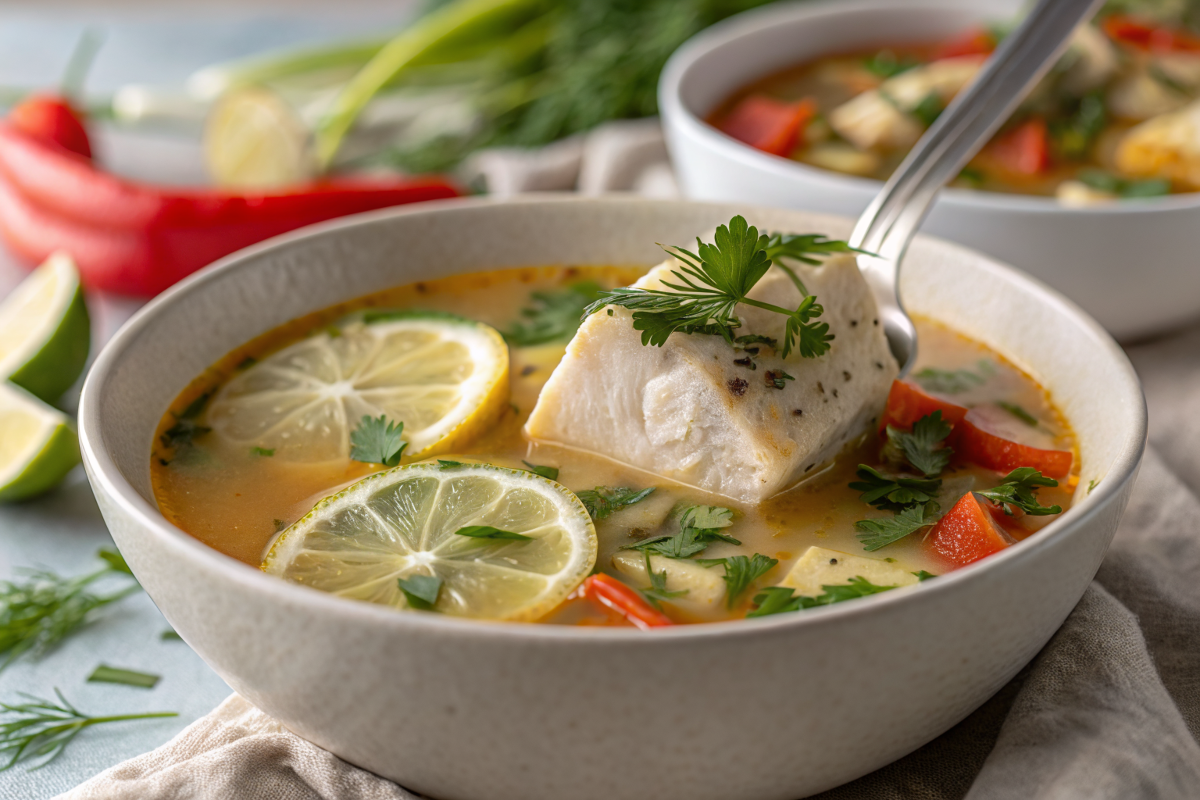
Serving Suggestions
Ladle the steaming hot soup into bowls. Garnish with fresh cilantro sprigs and a lime wedge for an extra squeeze of citrus. A sprinkle of red pepper flakes adds a pop of color and an extra layer of heat for those who like it spicy. Serve the soup in deep bowls to keep it warm.
This soup recipe was inspired by my grandmother’s cooking. She always used fresh, seasonal ingredients.
Consider serving this flavorful soup with a side of steamed rice to soak up the delicious broth. Crusty bread is another great option for dipping. For a lighter side, a refreshing Asian slaw with a tangy dressing complements the soup beautifully.
Pairing the Soup with Beverages
The vibrant flavors of this soup pair well with a crisp white wine like Sauvignon Blanc or Pinot Grigio. If you prefer red wine, choose a light-bodied option like Pinot Noir. For a non-alcoholic pairing, iced tea with a hint of lemon or lime is refreshing. Sparkling water with a squeeze of lime also complements the soup’s flavors without overpowering them.
Storing Leftovers
Store leftover soup in an airtight container in the refrigerator for up to 3 days. When reheating, gently warm the soup over medium heat on the stovetop. Avoid boiling, as this can cause the fish to overcook and become tough. You can also reheat individual portions in the microwave. Enjoy your delicious leftovers!
For another sweet treat, give my No-Bake Chocolate Raspberry Tart a try.
Frequently Asked Questions
Tom Yum Soup with Coconut Milk?
Tom Yum soup and this Spicy Coconut Lime Soup with Halibut both feature the tangy kick of lime and the richness of coconut milk. However, Tom Yum leans heavily on traditional Thai ingredients like galangal, kaffir lime leaves, and fish sauce for a distinctly umami flavor, often with added shrimp or mushrooms. Our recipe emphasizes the fresh flavors of lemongrass, ginger, and cilantro, creating a brighter, more herbaceous broth complemented by the halibut.
Thai Coconut Mushroom Soup?
Both recipes share the creamy base of coconut milk, but Thai Coconut Mushroom Soup typically focuses on earthy mushroom flavors, often incorporating ingredients like soy sauce and ginger for savory depth. Our Spicy Coconut Lime Soup with Halibut highlights the delicate flavor of the fish and the zesty brightness of lime, offering a lighter and more refreshing taste. To make our recipe vegetarian, simply substitute the halibut with firm tofu or hearty mushrooms like cremini or portobello.
Seafood Soup with Coconut Milk?
Coconut milk provides a wonderful base for various seafood soups due to its creamy texture and ability to complement delicate fish flavors. Besides halibut, other firm white fish like cod, snapper, or even shrimp work exceptionally well in coconut milk-based soups. You can also experiment with bolder-flavored seafood like salmon or tuna, adjusting the spices and aromatics to create a balanced and harmonious dish.
Coconut Milk Soup Ideas?
Coconut milk is a versatile ingredient that lends itself to a wide array of soup creations. Explore the possibilities with variations like curried coconut lentil soup, creamy coconut chicken and wild rice soup, or even a sweet coconut corn soup.
Conclusion: A Taste of Southeast Asia in Your Kitchen
This Spicy Coconut Lime Soup with Halibut brings the vibrant flavors of Southeast Asia right to your kitchen. It’s a surprisingly simple recipe that’s big on flavor and perfect for a weeknight meal or a special occasion. I encourage you to try this recipe and share the joy of this delicious and healthy soup with your family and friends. Let me know what you think! Cooking and sharing meals is a wonderful way to connect with loved ones. For more delicious and easy recipes inspired by my grandmother’s kitchen, be sure to explore the rest of my website. Happy cooking!
Print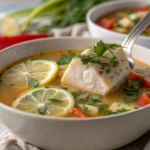
Introduction to Spicy Coconut Lime Soup with Halibut
- Prep Time: 10
- Cook Time: 10
- Total Time: 20 minutes
- Category: dinner
- Method: N/A
- Cuisine: america
Description
flavorful and healthy 30-minute meal, this Spicy Coconut Lime Soup with Halibut is bursting with fresh Southeast Asian flavors.
Ingredients
2 stalks Lemongrass
2-inch piece Ginger
4 cloves Garlic
1 medium Yellow onion
1 Red bell pepper
1 bunch Cilantro
2 Limes
1 (13.5 oz) can full-fat Coconut milk
2 tablespoons Fish sauce
1–2 tablespoons Chili garlic sauce
4 cups Vegetable broth
8 ounces Rice noodles
Fresh Halibut fillets (amount not specified – estimate 1 pound)
Instructions
1. Prepare Aromatics: Trim and chop lemongrass. Mince ginger and garlic. Dice onion.
2. Sauté Aromatics: Heat oil in a large pot over medium heat. Sauté lemongrass, ginger, garlic, and onion for 5-7 minutes until softened.
3. Build Broth: Add coconut milk and vegetable broth to the pot. Stir in fish sauce and chili garlic sauce. Simmer for 10 minutes.
4. Add Vegetables and Halibut: Add diced bell pepper to broth and cook for 5-7 minutes. Gently add halibut pieces and simmer for 5-7 minutes, or until fish is cooked through.
5. Finish: Remove from heat. Stir in lime juice and chopped cilantro. Add cooked rice noodles before serving. Garnish with extra cilantro and lime wedges.
Notes
Adjust chili garlic sauce to your spice preference. Substitute halibut with cod or snapper. Serve with rice or crusty bread. Store leftovers in an airtight container for up to 3 days.
Nutrition
- Serving Size: N/A
- Calories: N/A
- Sugar: N/A
- Sodium: N/A
- Fat: N/A
- Saturated Fat: N/A
- Unsaturated Fat: N/A
- Trans Fat: N/A
- Carbohydrates: N/A
- Fiber: N/A
- Protein: N/A
- Cholesterol: N/A
Keywords: Spicy Coconut Lime Soup, Halibut, Coconut Milk, Southeast Asian Cuisine, Fish Soup, Healthy Soup, 30-Minute Meal, Easy Recipe, Lemongrass, Ginger, Cilantro, Lime
